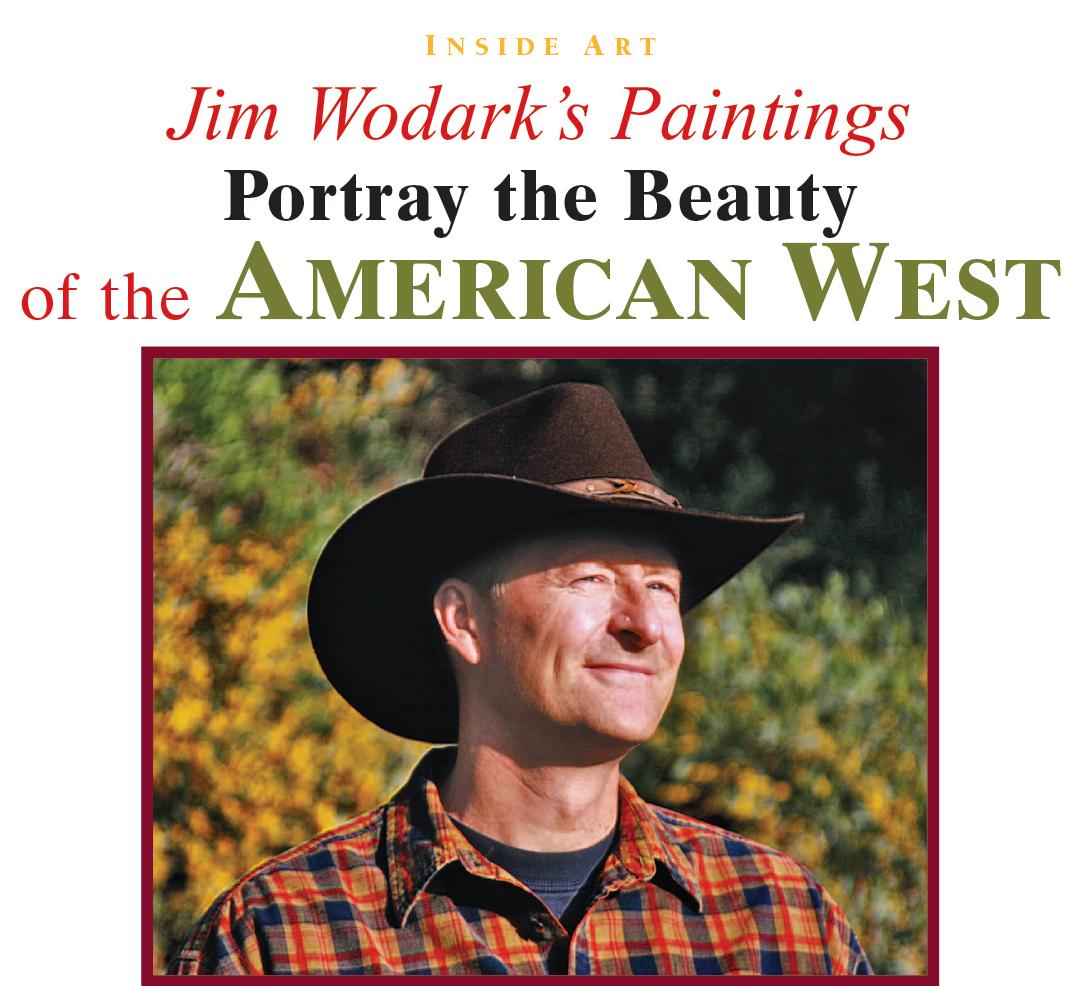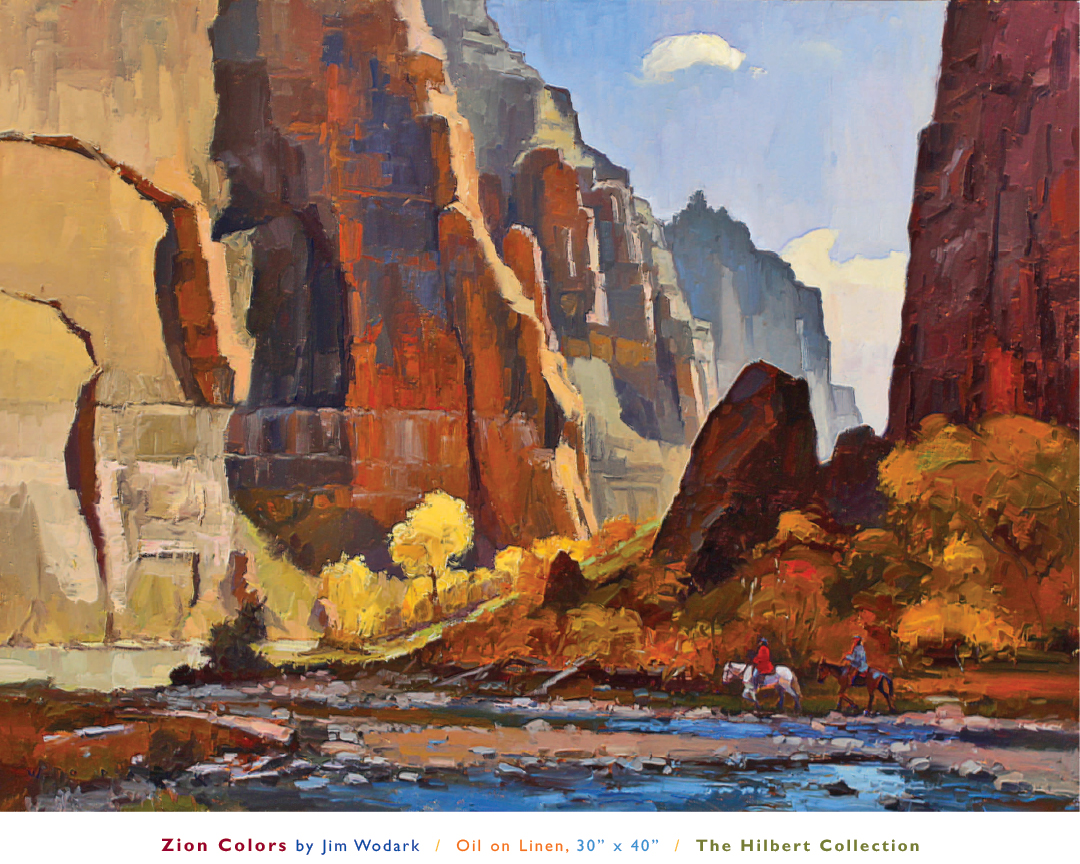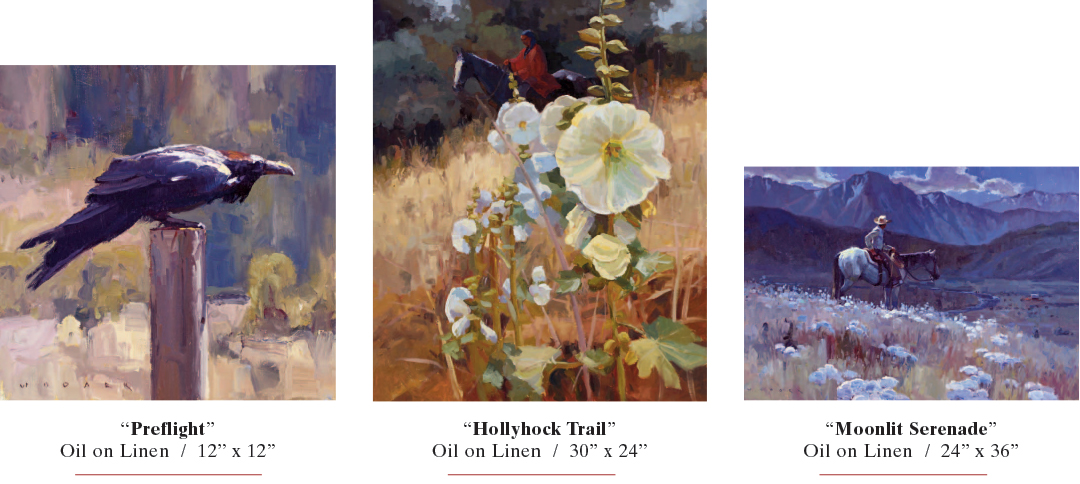
Jim Wodark
The wide-open skies of the vast American deserts, the rugged multihued rock walls of canyons and buttes, the ever-changing light of the West—from golden dawns to purple dusks—these are the subjects of acclaimed artist Jim Wodark’s oil paintings.
Wodark, a resident of Orange, is an award-winning plein-air painter born and raised in Colorado, so he knows the West by birthright. After achieving a marketing degree from the University of Northern Colorado (while attempting to fulfill his passion for art by taking an art class each semester), he embarked on a career in the corporate world, but soon found he wanted more in life.
For a while, projects in cartooning fulfilled that need, allowing him to use his drawing skills and keen sense of humor. “What I really wanted to do was be a cartoon-strip guy like ‘The Far Side’ or something,” Wodark says, “so I decided to move out here to California.” He adds that he also “met a girl,” which helped his decision.
That relationship didn’t work out, and he found the cartooning business to be a challenging way to make a living. For a while, he lived in San Diego, working on his business of creating cartoon maps of various college campuses. Then he met the woman who would become his wife. She lived in Orange County. The combination of love and art brought him to Orange.
“I started painting when I met her,” Wodark says. The couple purchased their home in Orange about 25 years ago, and the family now includes two (twin) daughters and a son, all now in their 20s.
The switch from cartooning to plein-air (painting outdoors in the open air) oil painting is a large leap, but it didn’t daunt Wodark. “Oil painting wasn’t really something I’d thought of doing back then. My wife was taking a watercolor class for fun, so I took the class just to play around with it, then I took another class in painting with acrylics, and finally I took a plein-air oil painting class in Laguna Beach, and I knew that was the medium I wanted to use. I enjoyed painting as much as cartooning, so I decided to stop cartooning and just paint for a living.”

Wodark loves oil painting because of the forgiveness of the medium. Oils dry slowly, so you can go back into them and revise sections of the painting if needed. Oils also offer another tool in expression—the thickness of the paint, which can be laid on in chunky dabs with brush or palette knife.
“To me, these paintings tell a story, much as my cartoons did,” Wodark explains. “It’s still an expression of what I want to say, and that is to bring something beautiful into people’s lives.”
Wodark travels to some of the most visually stunning regions of the West to work on his plein-air paintings, taking easel and paints out into the wilderness with him to capture the fleeting essence of light and color, both of which change throughout the day.
“Usually what I paint outdoors are smaller ‘sketches’—quick little paintings I can complete quickly to capture that ever-changing light,” he says. He also will use photography to freeze a moment of light and color and form in time. Then, back in his studio, he refers to the sketches and photos to complete a larger, much more detailed oil painting.
“When I look for a location outdoors to paint, it’s so many things coming together at one time,” he says. “For instance, the light is interesting, the subject matter is dramatic, or I think it’s beautiful. I wander around looking for places like that.”
The compositions of Wodark’s paintings are typically planned so that the addition of people as subject matter enhances the work. Horse riders are a favorite subject, making their way through towering canyons or fording rushing rivers. “The riders help me establish the size of the landmarks they move through, or they create a second focal point or even a little story within the painting.”

It is this storytelling aspect that attracted art collector and philanthropist Mark Hilbert to Wodark’s works. Hilbert often refers to the museum he founded at Chapman University in Orange, the Hilbert Museum of California Art, as a museum of narrative art.
“Jim’s paintings do tell a tale, and it’s often one of the vastness of our American wilderness, even today, and the enjoyment that people get from wandering through all that beauty,” says Hilbert. He purchased the painting shown on the inside front cover of this issue for the Hilbert Museum collection. “It’s a painting of riders in Zion National Park, and it caught my eye right away. I really admire Jim’s work.”
“I’m always trying to paint great paintings, aiming for that elusive ‘masterpiece’ status, and making that great statement,” says Wodark. “I’ve been doing this now for 25 years or more, and I don’t know if you ever get to what a masterpiece is. But what I like about the idea is that it constantly pulls you forward and impels you to keep examining and inquiring and reaching for that goal.”
For more information, to see more of Jim Wodark’s paintings and for galleries that carry his work, go to www.JimWodark.com. Locally, his paintings can often be seen at Chemers Gallery in Tustin.



